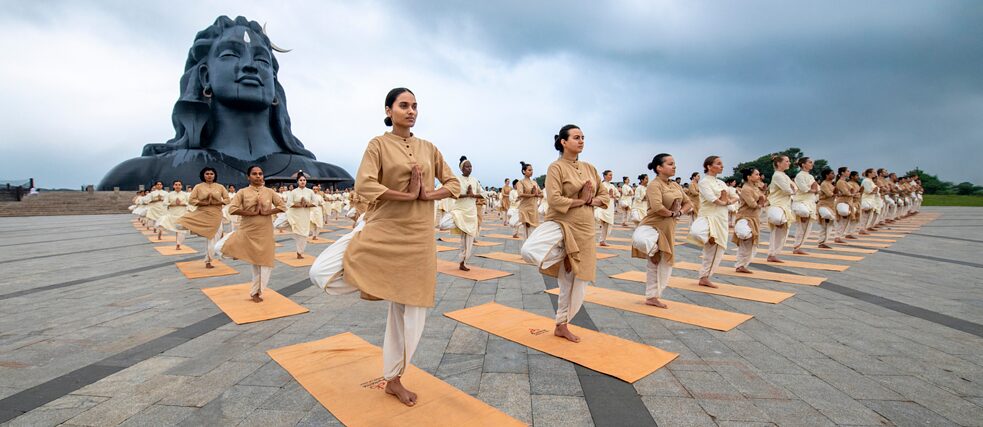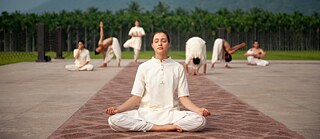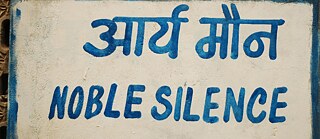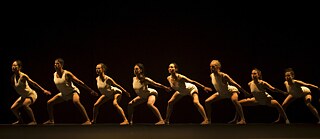Real Magic
The Search for Stillness Amidst Chaos
In moments of unrest, seeking stillness in yoga, meditation, and spirituality can be a guiding light.
When the world came to a screeching halt at the outbreak of the COVID-19 pandemic, people were plunged into the throes of crisis. We struggled, we survived, and somewhere between heartbreak and loss, dramatic lifestyle changes, the WFH culture, and a whole new perspective on the world around us and within us — we evolved. Over two years later, we are still navigating our way through the “new normal” with resilience. Our world will never be the same again. And neither will we.
What helped us endure? Stuck at home, people found ways to deal with the stress and shift brought on by countless quarantines — some new like the internet-breaking Dalgona coffee, TikTok trends, and the millennial boom in stock trading; some renewed like spending meaningful time with loved ones and picking up forgotten passions; and some ancient like yoga.
The idea of health, wellness, and inner well-being took on a new — urgent — meaning during the pandemic. More than ever amidst the rapid global disruptions, it was vital to pause, retreat, and come to rest.
Be it a desire for physical fitness, mental clarity, or spiritual growth, different paths lead different people to yoga. Recently, the practice has received a lot of attention worldwide for helping people cope with the pressures of the pandemic. But yoga is not just an escape from reality. It does not merely happen in the moments when your eyes are closed or your fingertips touch your toes — it is a way of experiencing life, in all its entirety, in every moment, with every breath.
Finding those moments of silence, awareness, bliss, clarity, and calm is always important for functioning effectively in this world and living in harmony with the universe. This becomes even more true in times of tribulation.
It may be bizarre to conceive of “being one with the universe” when you have to juggle the demands of modern life topped with pandemic-related woes, but in its essence, that is what yoga means: union. It is not just about stretching, bending, and breathing a certain way. Albeit potent, those are just the tools to get you to a state of perceiving life at the highest possible level. That is when the real magic happens.
Yet before we can even begin to fathom enlightenment, Mukti (liberation), or samadhi (the highest state of meditative consciousness), the benefits of yoga are powerful at every stage. The regular practice of asanas (physical postures), pranayama (breathing processes), and dhyana (meditation), among the other more subtle elements of yoga, can evoke phenomenal transformation in a human being. It relieves stress and anxiety, rejuvenates the body, boosts immunity, and can even provide relief from chronic health conditions. Beyond this, yoga enhances mental clarity, balances hormonal levels, strengthens the muscular and skeletal systems of the body, sharpens the mind, boosts energy and alertness, creates mental and emotional stability, improves productivity, and brings joy to everyday life. Anything is possible when you bring your body, mind, emotions, and energy to a certain balance.
The potential for positive change is vast, but it is not guaranteed. It depends on so many different factors, from the type of yoga you practice to the very mindset with which you approach it. For all this to flower within you and exude through everything you do, you first have to be still.
In yoga, they say it is by establishing stability of the body and stillness of the mind that you are empowered to experience life to the fullest and realize your capabilities. Among the many forms of yoga, hatha yoga is the science of mastering the body so that the mind and being can be in absolute stillness.
I remember one of the first hatha yoga classes I attended during my training to become a yoga teacher. A teacher dressed in simple white clothing gave instructions as another demonstrated the sun salutation. It was the most beautiful thing I had ever witnessed. The massive hall that seated over 150 fellow hatha yogis in the making felt instantly charged. Physics confirms that energy cannot be created or destroyed, merely transformed. The yogic science, much more ancient in its origins, has always suggested “oneness” or “union” — that the whole universe is essentially one energy. At that moment, science and mysticism married to create something so beautiful. It was electric. I was bursting with energy, and I wasn’t even “doing” any yoga yet! It wouldn’t be the last time yoga moved me to tears, to raptures of intensity, and finally, to complete stillness.
Yoga explores this paradox of movement and stillness — moving towards and beyond the duality of life. Sometimes, it looks like a yogi’s body is a blur of movement; sometimes, it settles into a profound stillness. Yet, it is the union of the two that can unleash something special and its transcendence that leads to the ultimate goal.
 Yoga means “union”
| © Isha Foundation
Today, there are many different schools and styles of yoga, with some steeped in strong classical traditions to completely modern-day interpretations. The International Day of Yoga, celebrated on June 21st since 2015, is a testament to the global resurgence of yoga in the 21st century — which has only received a greater boost in the wake of the pandemic. Despite its multiplicity, one thing is clear: Yoga, which was once deeply woven into the cultural fabric of India, is quickly becoming part of a vibrant international mosaic. As millions of people across the world are rediscovering yoga in modern times, it is becoming important to understand and preserve its authenticity.
Yoga means “union”
| © Isha Foundation
Today, there are many different schools and styles of yoga, with some steeped in strong classical traditions to completely modern-day interpretations. The International Day of Yoga, celebrated on June 21st since 2015, is a testament to the global resurgence of yoga in the 21st century — which has only received a greater boost in the wake of the pandemic. Despite its multiplicity, one thing is clear: Yoga, which was once deeply woven into the cultural fabric of India, is quickly becoming part of a vibrant international mosaic. As millions of people across the world are rediscovering yoga in modern times, it is becoming important to understand and preserve its authenticity.
If you think of yoga in ancient times, you might conjure the image of a yogi performing asanas in a loosely-tied loincloth, perhaps on the grass under the shade of a tree or in a Himalayan cave or, quite possibly, on the earthen floors of homes across the Indian subcontinent — an everyday act so simply entwined into cultural life since time immemorial. Things have changed dramatically now, in India and the world over. It is difficult to reconcile this image with an era of body-hugging yoga pants, colorful mats, “beer yoga,” and all kinds of equipment. When sweat becomes the barometer for progress in a yoga class, the quest for spirituality is arguably dampened. Yoga is a most natural human process that has carried on for millennia without much fuss. Yet as always, the world shifts, shuffles, and struggles through different stages — some constructive and some controversial — before settling. As more and more people seek yoga, the hope is to find our way back to its roots in the most meaningful way.
Like the shock of the pandemic, as we hurtle towards a future that may be full of surprises, challenges, and opportunities — yoga can prepare us to take on life with ease, grace, intelligence, and sensitivity. If our interiority is balanced, we can blossom in even the most pressing times.
The search for stillness amidst chaos is only natural. An inherent instinct to survive, to thrive. We need something to tether us to life when the world seems to be spinning out of control at a breakneck pace. But imagine — if a simple stretch or breathing consciously can lift you up when you’re down — what the limit to your experience and capabilities would be if you were in yoga all the time? When you are at the peak of health, wellness, and inner well-being, you can tap into a different dimension of existence altogether. The possibilities are infinite. Wouldn’t it be a beautiful world, where you can be still and explode with life and action — all at the same time?
What helped us endure? Stuck at home, people found ways to deal with the stress and shift brought on by countless quarantines — some new like the internet-breaking Dalgona coffee, TikTok trends, and the millennial boom in stock trading; some renewed like spending meaningful time with loved ones and picking up forgotten passions; and some ancient like yoga.
The idea of health, wellness, and inner well-being took on a new — urgent — meaning during the pandemic. More than ever amidst the rapid global disruptions, it was vital to pause, retreat, and come to rest.
Be it a desire for physical fitness, mental clarity, or spiritual growth, different paths lead different people to yoga. Recently, the practice has received a lot of attention worldwide for helping people cope with the pressures of the pandemic. But yoga is not just an escape from reality. It does not merely happen in the moments when your eyes are closed or your fingertips touch your toes — it is a way of experiencing life, in all its entirety, in every moment, with every breath.
Finding those moments of silence, awareness, bliss, clarity, and calm is always important for functioning effectively in this world and living in harmony with the universe. This becomes even more true in times of tribulation.
It may be bizarre to conceive of “being one with the universe” when you have to juggle the demands of modern life topped with pandemic-related woes, but in its essence, that is what yoga means: union. It is not just about stretching, bending, and breathing a certain way. Albeit potent, those are just the tools to get you to a state of perceiving life at the highest possible level. That is when the real magic happens.
Yet before we can even begin to fathom enlightenment, Mukti (liberation), or samadhi (the highest state of meditative consciousness), the benefits of yoga are powerful at every stage. The regular practice of asanas (physical postures), pranayama (breathing processes), and dhyana (meditation), among the other more subtle elements of yoga, can evoke phenomenal transformation in a human being. It relieves stress and anxiety, rejuvenates the body, boosts immunity, and can even provide relief from chronic health conditions. Beyond this, yoga enhances mental clarity, balances hormonal levels, strengthens the muscular and skeletal systems of the body, sharpens the mind, boosts energy and alertness, creates mental and emotional stability, improves productivity, and brings joy to everyday life. Anything is possible when you bring your body, mind, emotions, and energy to a certain balance.
The potential for positive change is vast, but it is not guaranteed. It depends on so many different factors, from the type of yoga you practice to the very mindset with which you approach it. For all this to flower within you and exude through everything you do, you first have to be still.
In yoga, they say it is by establishing stability of the body and stillness of the mind that you are empowered to experience life to the fullest and realize your capabilities. Among the many forms of yoga, hatha yoga is the science of mastering the body so that the mind and being can be in absolute stillness.
"Yoga explores this paradox of movement and stillness — moving towards and beyond the duality of life."
Yoga explores this paradox of movement and stillness — moving towards and beyond the duality of life. Sometimes, it looks like a yogi’s body is a blur of movement; sometimes, it settles into a profound stillness. Yet, it is the union of the two that can unleash something special and its transcendence that leads to the ultimate goal.
 Yoga means “union”
| © Isha Foundation
Today, there are many different schools and styles of yoga, with some steeped in strong classical traditions to completely modern-day interpretations. The International Day of Yoga, celebrated on June 21st since 2015, is a testament to the global resurgence of yoga in the 21st century — which has only received a greater boost in the wake of the pandemic. Despite its multiplicity, one thing is clear: Yoga, which was once deeply woven into the cultural fabric of India, is quickly becoming part of a vibrant international mosaic. As millions of people across the world are rediscovering yoga in modern times, it is becoming important to understand and preserve its authenticity.
Yoga means “union”
| © Isha Foundation
Today, there are many different schools and styles of yoga, with some steeped in strong classical traditions to completely modern-day interpretations. The International Day of Yoga, celebrated on June 21st since 2015, is a testament to the global resurgence of yoga in the 21st century — which has only received a greater boost in the wake of the pandemic. Despite its multiplicity, one thing is clear: Yoga, which was once deeply woven into the cultural fabric of India, is quickly becoming part of a vibrant international mosaic. As millions of people across the world are rediscovering yoga in modern times, it is becoming important to understand and preserve its authenticity.If you think of yoga in ancient times, you might conjure the image of a yogi performing asanas in a loosely-tied loincloth, perhaps on the grass under the shade of a tree or in a Himalayan cave or, quite possibly, on the earthen floors of homes across the Indian subcontinent — an everyday act so simply entwined into cultural life since time immemorial. Things have changed dramatically now, in India and the world over. It is difficult to reconcile this image with an era of body-hugging yoga pants, colorful mats, “beer yoga,” and all kinds of equipment. When sweat becomes the barometer for progress in a yoga class, the quest for spirituality is arguably dampened. Yoga is a most natural human process that has carried on for millennia without much fuss. Yet as always, the world shifts, shuffles, and struggles through different stages — some constructive and some controversial — before settling. As more and more people seek yoga, the hope is to find our way back to its roots in the most meaningful way.
The search for stillness amidst chaos is only natural. An inherent instinct to survive, to thrive. We need something to tether us to life when the world seems to be spinning out of control at a breakneck pace.
The search for stillness amidst chaos is only natural. An inherent instinct to survive, to thrive. We need something to tether us to life when the world seems to be spinning out of control at a breakneck pace. But imagine — if a simple stretch or breathing consciously can lift you up when you’re down — what the limit to your experience and capabilities would be if you were in yoga all the time? When you are at the peak of health, wellness, and inner well-being, you can tap into a different dimension of existence altogether. The possibilities are infinite. Wouldn’t it be a beautiful world, where you can be still and explode with life and action — all at the same time?






